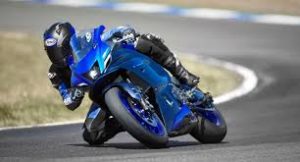In the realm of motorcycling, the presence of a full fairing and clip-on handlebars often heralds something exceptional. Yet, what occurs when this notion of “exceptional” begins to feel excessively demanding, relentless, and unattainable for the everyday sportbike enthusiast? Where does one seek refuge when desiring a traditional sportbike experience, accompanied by a measure of detachment from the race-inspired models that seem ill-suited for a mundane Monday commute?
In 2021, Yamaha unveiled its inaugural answer to this conundrum—the pragmatic, parallel-twin-powered YZF-R7. Now, the esteemed manufacturer is reaffirming its dedication to crafting more versatile and accessible supersport motorcycles with the eagerly awaited YZF-R9, set to debut in March 2025 at a price of $12,499 (10.5 lakhs INR)

Indeed, what was once mere speculation has materialized into reality, as Yamaha officially incorporates the YZF-R9 into its illustrious R-Series lineup, which in the United States encompasses a range from the R1 and R1M to the R7 and the entry-level R3.
Crucially, Yamaha emphasizes that the R9 is neither a replacement for existing models nor a substitute for the street-legal R6, which was retired in 2020. Instead, it represents an entirely new concept emerging from a notable shift in market trends.
“As we look back at supersport models from the early 2000s, the focus was predominantly on showcasing the latest and most advanced specifications,” remarks Aaron Bast, senior motorcycle product planner at Yamaha Motor. “Much of the performance offered was beyond what the average rider would realistically utilize on public roads. Today, however, there is a greater emphasis on rational choices and thoughtful decisions, even within the supersport segment. This motorcycle is crafted for winding two-lane roads, yet it remains fully capable on the racetrack.”

The R9 harnesses a repurposed 890cc CP3 inline three-cylinder engine from the MT-09, enhancing its performance with revised ECU settings and taller gearing (16/45 as opposed to 16/43), ensuring a more balanced power delivery in contrast to the exuberant nature of the MT-09. Aside from these adjustments, the engine remains unchanged, although it is noteworthy that Yamaha undertook a comprehensive redesign of this powerplant in 2021. Almost every significant component—from pistons and connecting rods to the crankshaft, camshafts, and crankcase—was meticulously reengineered and lightened to reduce overall weight and augment torque.
For context, an XSR900 utilizing the same engine achieved 106 horsepower at 9,970 rpm and 63.5 lb.-ft. of torque at 7,030 rpm on the Cycle World dynamometer. Anticipate minor variations in the R9 that may slightly alter these figures (and the power curve).
The R9 features a less familiar frame, specifically crafted for this model. It aims to achieve an equilibrium between a supple, predictable feel at city speeds and optimal rigidity for precise handling on the racetrack. Its geometry is notably more aggressive than that of the MT-09, with a wheelbase of 55.9 inches (compared to 56.3 inches), a rake of 22.3 degrees (as opposed to 24.7 degrees), and a trail measurement of 3.7 inches (versus 4.3 inches).
Yamaha asserts that this is the lightest aluminum frame ever incorporated into a Yamaha supersport model, contributing significantly to the bike’s total weight of a claimed 430 pounds. For perspective, the 2020 R6 weighed in at a claimed 419 pounds.

The suspension system features KYB’s innovative 43mm Separate-Damping Front Fork (SDF), equipped with adjustable high- and low-speed compression damping (left leg), rebound damping (right leg), and preload. Additionally, the R9 boasts a fully adjustable KYB shock with a remote preload adjuster—indicative of Yamaha’s more performance-oriented approach compared to the R7, which utilizes a tubular-steel double backbone frame and a shock with non-adjustable compression damping. While the comparison may not be entirely equitable, the difference in hardware highlights the enhanced potential of the R9 and suggests it will serve as an excellent progression for riders seeking to elevate their experience after a few years on an R7.
The bike’s overall dimensions further bolster this assertion. It is noticeably larger than the R7, featuring a broader tank and increased space in the saddle. While it may not be entirely fair to use the R7 as a direct benchmark, doing so elucidates Yamaha’s strategic direction with the R9; whereas the R7 has been streamlined for weight and accessibility, the R9 embodies genuine substance and a robust big-bike presence.
These larger dimensions are expected to enhance comfort for a broader spectrum of riders. However, Yamaha is not solely relying on the R9’s size to improve comfort; in nearly every discussion with Yamaha personnel, emphasis is placed on the increased gap between the footpeg and seat, which exceeds that of the R1, potentially contributing to an overall sense of comfort during street riding. The quotation marks around “comfort” indicate that, despite this, the bike remains a sportbike, with a rider triangle that reflects that identity.
Moreover, the clip-on handlebars are positioned below the top triple clamp and lack risers, adhering to traditional sportbike aesthetics. This setup is designed to provide a riding position that strikes a balance between the R1 and R7, theoretically offering relief on longer street journeys while maintaining a natural and committed stance for track use.
Speaking of racetracks and the performance-oriented aspects of the R9, Yamaha claims this to be its most aerodynamic sportbike to date. The incorporation of winglets is not merely a fashionable trend; they provide tangible downforce at track speeds. The overall aesthetic aligns with typical Yamaha sportbike design, yet model-specific lines ensure the R9 distinguishes itself within the R lineup, marking it as a notable evolution in Yamaha’s sportbike offerings. It would have been disappointing had the R9 simply echoed the designs of the R1 or R7 and blended into the background, but fortunately, that is far from the case.
Enthusiasts of electronic rider aids will find much to appreciate, as the R9 is equipped with a comprehensive electronics package. Available features include a four-level Power Delivery Mode (PWR), a nine-level lean-sensitive Traction Control System (TCS), a three-level Lift Control System (LIF), a three-level Slide Control System (SCS), a two-level Engine Brake Management (EBM), a Back Slip Regulator (BSR), a lean-sensitive Brake Control System (BC), Launch Control (LC), a rear ABS off function, and a bidirectional quickshifter. One might jest that a few more systems could be added if Yamaha could devise additional acronyms. Nonetheless, it’s hard to conceive of needing more than this robust array for either track or street riding.
The R9 features four pre-configured ride modes—Sport, Street, Rain, and Track—alongside two customizable options, enabling riders to tailor settings for various riding conditions. All adjustments can be easily made via a 5-inch TFT display, utilizing the user-friendly switch cluster borrowed from Yamaha’s latest-generation MT-09.
Additional conveniences include span-adjustable levers and cruise control. The R9 is also equipped with Brembo Stylema front brake calipers, connected to steel-braided brake lines and operating on substantial 320mm discs, ensuring powerful and responsive braking performance.
If it feels as though you’re experiencing whiplash from the contrast between street-centric design philosophies and high-performance, track-oriented features, it’s because the R9’s entire essence resides in the intersection of these realms. Yet, it arguably tilts more towards the aggressive side than one might expect, showcasing a high-caliber approach that surpasses what familiar R7 riders might anticipate.
This is not to critique the R7; rather, it highlights Yamaha’s commitment to making the R9 a genuine advancement from the CP2 twin. It is a motorcycle poised to attract the attention of traditional 600cc supersport riders in search of a bit more practicality. Come for the full fairing and clip-ons, stay for the enhanced comfort and versatility—it’s a compelling proposition indeed.






